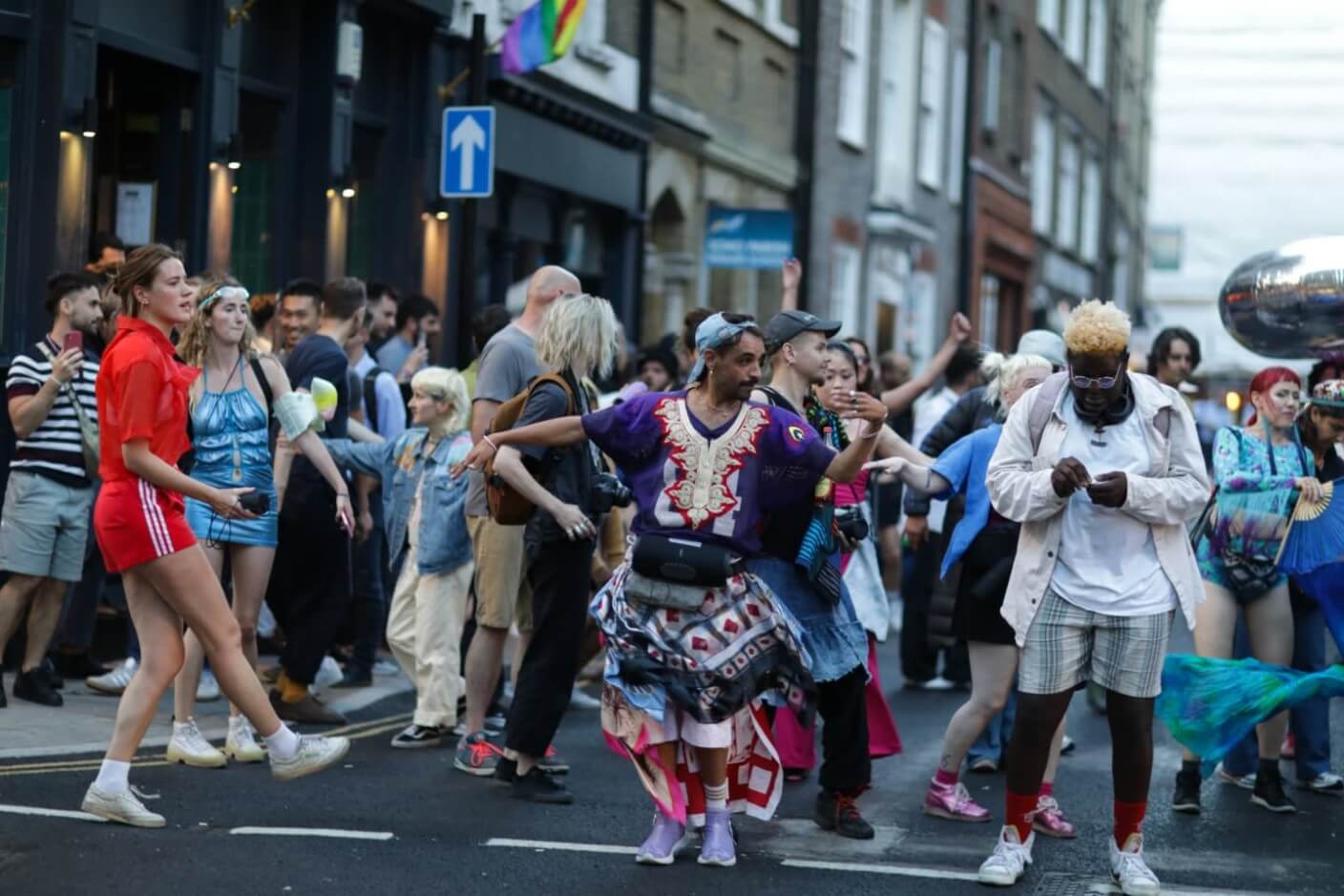Choreography
Written by Floor van Leeuwen

Choreography
Swarm's mimography (mime-choreography) is based on the movement principles of swarms. Essential in the swarm is that the collective determines when, how and where movement occurs. Power is decentralized, so to speak. In swarm, there are three rules of the game:
1. make space
2. stay together
3. negotiate where you will go, as you move along
Birds in a swarm keep a social distance of three body lengths from each other. In Swarm, that spacing is a movable scale, from space 1 (close together) to space 10 (far apart). In a traditional gathering, people usually move shoulder to shoulder; the group forms a block to which everything and everyone must give way. In Swarm, space remains between people. This creates an open group that you can walk through as a passerby; that can dance like a grid through an existing mass, and that you can spontaneously join. In addition, this space provides freedom of movement for wheelchair dancers, among others, who cannot move well in traditional congregations, such as a dance party or demonstration.
To determine the direction of the swarm together, participants practice turning their attention 360 degrees around themselves. New participants often embody a hierarchy - they follow the one in front of them. With 360-degree awareness, the audience practices a collective way of decision-making, where change is possible from any position in the group.
Dance
The dance of swarm is as you like it. During the warm up the ‘scales’ excersice is introduced, where you move in scales from 1-10. The scale of volume is how big or small you move, the scale of speed is how fast and slow, and the scale of space is the amount of space in between each other. By using the scales the dance exercises can be interpreted in different styles and with different physical abilities. Because we move through the streets, unlike a club, you have to move to stay with it. This often leads to people who say they never danced in a club suddenly dancing a lot during swarm. As they walked on the beat, they walked into dancing.
Sound
Swarmers carry small speakers that are connected together via Bluetooth, creating a mobile speakersystem.
Regular soundsystems consist of one or more big speakers. People often tend to move towards the speakers, becoming more dense as a crowd in that process. The sound from these speakers needs to be loud in order to reach the whole crowd, which can be experienced as noise in public space by those who did not choose to hear it. Lastly, big speakers direct the crowd's movement, as a participant you need to follow the speaker in order to hear the music (and if it doesn’t move, neither will you).
Swarm’s mobile soundsystem travels wherever the body takes us, on squares, stairs, tunnels, crossroads and parcs. Speakers are carried in small crossbody ‘speakerbags’, allowing participants to move freely. Participants decide where to go, what spaces to transform in temporal dance spaces. And as the sound is so close to the body, the volume can be relatively low, so that sound is therefor less invasive in public space.
The DJ plays a live set via a tablet. The DJ responds to the changing surroundings; for instance lowering the volume in a neighborhood late at night, and raising it on a bridge. Turning it off when passing by streetmusicians or spaces of worship, and on again once passed by. Also the quality of music is adapted to where we are and who and what we meet.
Team
The swarm is built up with people who have different levels of engagement, experience and focus.
A swarm consists of:
Coregroup
Participants
Spontaneous participants
A coregroup that has practised swarming is amidst participants joining for the first time. This way the swarm practice is shared tacitly, while learning new things every time. Within the coregroup there are two roles: energisers and boundary. Energisers focus on dancing, freedom of expression and movement, and connecting through movement with those around them. The boundary is focused on the exchange between the swarm and the people it meets. As a swarm we aim to share the space, not take it over. The boundary can inform, de-escalate, aswell as change the route of the swarm.
Participants are introduced to the Swarm via an introduction and a warm up in the beginning.
During the swarm people (and at times also cats, dogs and birds) join the swarm spontaneously. Some dance with us for a short while, or cheer us on, some step in and stay until the end.
Visual elements
The speakers are carried unnoticeably in small crossbody speakerbags, so that swarmers and people joining spontaneously have no visual difference. Within regular flashmobs and performances a studied choreography, costumes and other visual elements create a distinction between participants ‘who are in the know’ and spectators. With Swarm it is hard to see who was there from the start and who joined in later. This lowers the threshold of participation. Furthermore it allows the swarm to dissolve in a larger crowd.
Collaboration
Swarms emerge from collaboration, and through collaboration adapt to different contexts. For this we work with a collective workmodel designed by Roberto P. Gayo. Over time different trajectories have been developed. We’ve worked within mental health, activism, architecture, and culture.